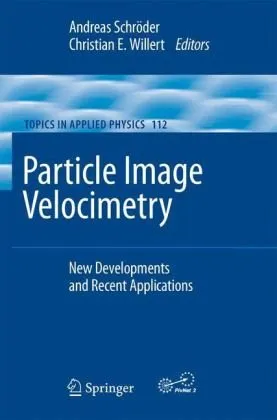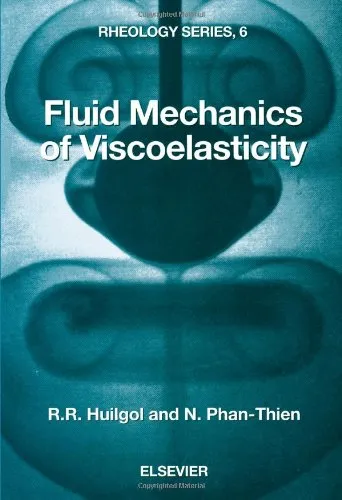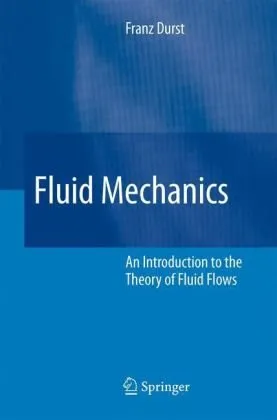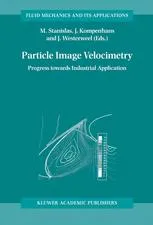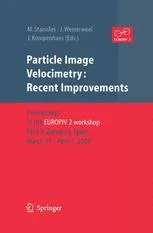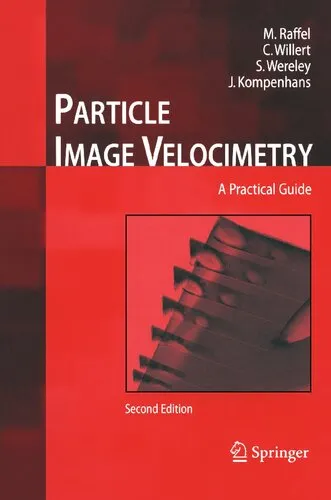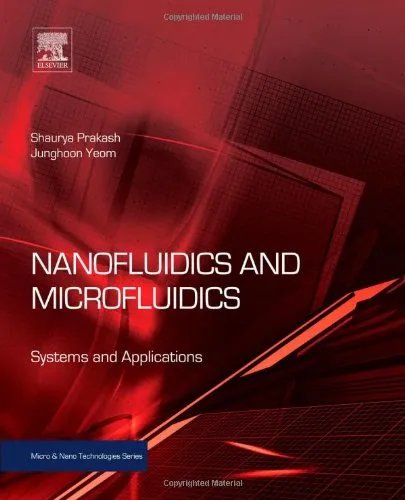Particle image velocimetry: new developments and recent applications
4.0
بر اساس نظر کاربران

شما میتونید سوالاتتون در باره کتاب رو از هوش مصنوعیش بعد از ورود بپرسید
هر دانلود یا پرسش از هوش مصنوعی 2 امتیاز لازم دارد، برای بدست آوردن امتیاز رایگان، به صفحه ی راهنمای امتیازات سر بزنید و یک سری کار ارزشمند انجام بدینکتاب های مرتبط:
مقدمه کتاب "Particle Image Velocimetry: New Developments and Recent Applications"
کتاب "Particle Image Velocimetry: New Developments and Recent Applications" نوشته "Andreas Schröder، Andreas Schröder، Christian E. Willert"، یکی از منابع جامع و پیشرفته در زمینه تکنیکهای معتبر مطالعه جریان سیالات به شمار میرود. این کتاب موجز، تخصصی و مناسب پژوهشگران، مهندسان و دانشجویانی است که تمایل به درک عمیقتر ابزارهای مدرن همچون PIV یا Particle Image Velocimetry دارند.
خلاصهای از کتاب
این کتاب به بررسی نوآوریها و کاربردهای جدید در تکنولوژی PIV پرداخته و با ارائه جزئیات دقیق علمی، راهکارهایی برای پژوهش در زمینههای متفاوت مانند آیرودینامیک، هیدرودینامیک، و موارد مشابه ارائه کرده است. نویسندگان با استفاده از شواهد تجربی، کمک کردهاند که خواننده بتواند به عمق محتوای علمی و عملی این حوزه راه پیدا کند. همچنین، تئوریهای جدید و بهروزی که به افزایش دقت و بازدهی در اندازهگیریهای میدان سرعت منجر میشوند نیز بهخوبی توضیح داده شده است.
نکات کلیدی
- بررسی جامع تکنیکهای PIV و نرمافزارهای مرتبط
- مطالعه کاربرد PIV در صنایع مختلف از جمله آیرودینامیک و زیستمحیطی
- شناخت چالشهای اندازهگیری و راهحلهای پیشنهادی
- تحلیل پیشرفتهای اخیر در زمینه ادغام تکنیکهای تصویربرداری دیجیتال
- شرح دادههای آزمایشی برای شبیهسازی جریان سیالات پیچیده
جملات معروف از کتاب
"The effectiveness of PIV lies in its ability to provide spatially resolved velocity measurements over complex flow fields."
"Continuous innovation in Particle Image Velocimetry exemplifies our commitment to understanding fluid mechanics at unparalleled depths."
اهمیت این کتاب
اهمیت کتاب "Particle Image Velocimetry: New Developments and Recent Applications" بهواسطه تمرکز آن بر پژوهشهای بهروز و ارائه راهکارهایی برای حل مسائل پیچیده در علم مکانیک سیالات برجسته میشود. این اثر نهتنها به مهندسان و دانشمندان کمک میکند تا درک بهتری نسبت به جریان سیالات پیدا کنند، بلکه ابزاری عملی را نیز برای استفاده از تکنولوژی پیشرفته در پروژههای واقعی فراهم میآورد. مطالعه این کتاب، مسیر پیشرفت تکنولوژی PIV و ارزش آن در کاربردهای صنعتی و تحقیقاتی را آشکار میکند.
اگر هدف شما درک بهتر از جریانهای سیالات پیچیده با استفاده از ابزارهای پیشرفته است، این کتاب یک ضرورت محسوب میشود. بهویژه برای افرادی که به بهبود عملکرد تجهیزات آیرودینامیک و یا کشف راهحلهای نوآورانه برای کاهش مصرف انرژی علاقهمند هستند.
Introduction to "Particle Image Velocimetry: New Developments and Recent Applications"
"Particle Image Velocimetry: New Developments and Recent Applications" is an authoritative resource that delves into the advanced methodologies and real-world applications of particle image velocimetry (PIV). Authored by Andreas Schröder and Christian E. Willert, this book serves as both an introduction for those new to the field and a rich compendium for researchers and professionals seeking to expand their expertise. Combining theoretical insights with practical case studies, it presents a holistic view of PIV as a pivotal tool in fluid dynamics and related engineering applications.
Detailed Summary of the Book
The book provides an in-depth exploration of particle image velocimetry, a cutting-edge technique for studying fluid flow by visualizing and quantifying dynamic movements. Starting with the foundational principles of PIV, the authors guide the reader through the evolution of the technology, highlighting breakthroughs that have made PIV both more accessible and versatile.
The text is structured to balance theory and practice. Early chapters focus on the physical principles behind PIV, such as particle seeding, laser illumination, and image acquisition. Then, the authors delve into computational methods, such as correlation algorithms and velocity field reconstruction, which are crucial for converting raw data into meaningful insights.
As the book progresses, more complex topics are introduced, including advanced imaging techniques like stereo-PIV and time-resolved PIV. The authors also discuss innovations such as tomographic PIV and its application to three-dimensional flow analysis. Furthermore, real-world examples in aerodynamics, turbulence studies, and biofluid mechanics are used to illustrate how PIV can address challenging questions across various disciplines.
In addition to technical concepts, the book provides practical guidance on experimental setup and troubleshooting common problems. Comprehensive discussions on errors, uncertainties, and methods for data validation ensure the reader can apply PIV effectively and with confidence.
Key Takeaways
- Comprehensive coverage of particle image velocimetry, from basic to advanced topics.
- Explanations of core mathematical principles, tailored for both newcomers and experienced users.
- Practical advice on experimental design, including lighting, seeding techniques, and equipment calibration.
- Insight into modern advancements, such as tomographic and time-resolved PIV systems.
- Real-world applications across a range of industries, providing relatable examples for researchers and engineers.
Famous Quotes from the Book
"Understanding fluid dynamics is not merely about observing motion—it’s about uncovering the mechanisms that drive it."
"Modern PIV techniques illuminate the invisible world of flow, turning turbulence into a canvas of discovery."
"The advances in PIV are not just technical—they redefine what is scientifically possible in fluid analysis."
Why This Book Matters
Particle image velocimetry has become an indispensable tool for researchers, engineers, and scientists across numerous fields, from aerospace to biomedical engineering. This book captures the essence of why PIV is a revolutionary technology, bridging the gap between theoretical principles and practical application. By documenting recent advancements, it ensures readers stay on the cutting edge of fluid dynamics research.
For educators, this book provides a structured guide to introducing PIV concepts in an academic setting. For practitioners, it offers solutions to real-world challenges, accompanied by case studies that demonstrate the transformative power of PIV across industries. Furthermore, it maintains a balance that appeals to both experts seeking depth and newcomers eager for clarity.
In a world where understanding and controlling fluid dynamics can lead to breakthroughs in sustainability, energy efficiency, and healthcare, the knowledge offered in this book is not just valuable—it is necessary.
دانلود رایگان مستقیم
شما میتونید سوالاتتون در باره کتاب رو از هوش مصنوعیش بعد از ورود بپرسید
دسترسی به کتابها از طریق پلتفرمهای قانونی و کتابخانههای عمومی نه تنها از حقوق نویسندگان و ناشران حمایت میکند، بلکه به پایداری فرهنگ کتابخوانی نیز کمک میرساند. پیش از دانلود، لحظهای به بررسی این گزینهها فکر کنید.
این کتاب رو در پلتفرم های دیگه ببینید
WorldCat به شما کمک میکنه تا کتاب ها رو در کتابخانه های سراسر دنیا پیدا کنید
امتیازها، نظرات تخصصی و صحبت ها درباره کتاب را در Goodreads ببینید
کتابهای کمیاب یا دست دوم را در AbeBooks پیدا کنید و بخرید
1165
بازدید4.0
امتیاز0
نظر98%
رضایتنظرات:
4.0
بر اساس 0 نظر کاربران
Questions & Answers
Ask questions about this book or help others by answering
No questions yet. Be the first to ask!
